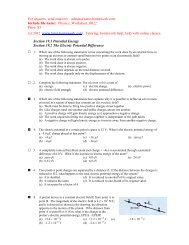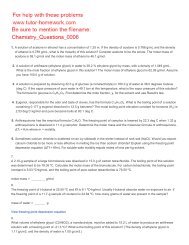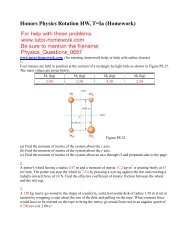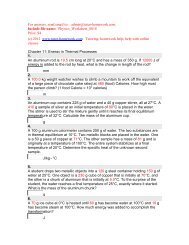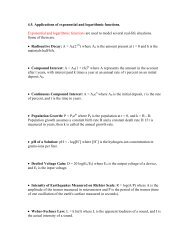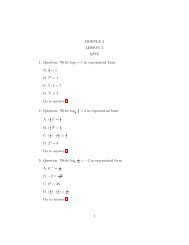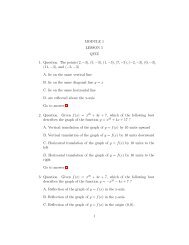Section 1 - Tutor-Homework.com
Section 1 - Tutor-Homework.com
Section 1 - Tutor-Homework.com
- No tags were found...
You also want an ePaper? Increase the reach of your titles
YUMPU automatically turns print PDFs into web optimized ePapers that Google loves.
chapterINTERFERENCE AND THEWAVE NATURE OF LIGHTwww.tutor-homework.<strong>com</strong> (for tutoring, homework help, or help with online classes)<strong>Section</strong> 27.1 The Principle of Linear Superposition<strong>Section</strong> 27.2 Young’s Double Slit Experiment 1.Complete the following sentence: The term coherence relates to(a) the phase relationship between two waves. (d) the amplitude of two waves.(b) the polarization state of two waves.(e) the frequency of two waves.(c) the diffraction of two waves. 2. Two identical light waves, A and B, are emitted from different sources and meet at a point P. Thedistance from the source of A to the point P is L A ; and the source of B is a distance L B from P.Which of the following statements is necessarily true concerning the interference of the two waves?(a) A and B will interfere constructively because their amplitudes are the same.(b) A and B will interfere constructively if L A = L B .(c) A and B will interfere destructively if L A L B = m where m = 0, 1, 2, 3, ...(d) A and B will interfere destructively if L A is not equal to L B .(e) A and B will interfere constructively because their wavelengths are the same. 3. Which one of the following statements provides the most convincing evidence that visible light isa form of electromagnetic radiation?(a) Two light sources can be coherent.(b) Light can be reflected from a surface.(c) Light can be diffracted through an aperture.(d) Light can form a double-slit interference pattern.(e) Light travels through vacuum at the same speed as X-rays. 4. Which one of the following statements best explains why interference patterns are not usuallyobserved for light from two ordinary light bulbs?(a) Diffraction effects predominate.(b) The two sources are out of phase.(c) The two sources are not coherent.(d) The interference pattern is too small to observe.(e) Light from ordinary light bulbs is not polarized. 5. A double slit is illuminated with monochromatic light of wavelength 6.00 10 2 nm.The m = 0 and m = 1 bright fringes are separated by 3.0 cm on a screen which is located 4.0 mfrom the slits. What is the separation between the slits?(a) 4.0 10 5 m (c) 1.2 104 m (e) 2.4 104 m(b) 8.0 10 5 m(d) 1.6 104 m 6. What does one observe on the screen in a Young’s experiment if white light illuminates the doubleslit instead of light of a single wavelength?(a) a white central fringe and no other fringes
278 Chapter 27 Interference and the Wave Nature of Light(b) a dark central fringe and a series of alternating white and dark fringes on each side of the center(c) a white central fringe and a series of colored and dark fringes on each side of the center(d) a continuous band of colors with no dark fringes anywhere(e) a dark screen since no constructive interference can occur 7. In two separate double slit experiments, an interference pattern is observed on a screen. In thefirst experiment, violet light ( = 754 nm) is used and a second-order bright fringe occurs at thesame location as a third-order dark fringe in the second experiment. Determine the wavelength ofthe light used in the second experiment.(a) 1320 nm (c) 594 nm (e) 388 nm(b) 862 nm(d) 431 nm• 9. Two slits are separated by 2.00 10 5 m. They are illuminated by light of wavelength 5.60 10 7 m.If the distance from the slits to the screen is 6.00 m, what is the separation between the central brightfringe and the third dark fringe?(a) 0.421 m (c) 0.168 m (e) 0.070 m(b) 0.224 m(d) 0.084 m• 10. In a Young's double slit experiment, the separation between the slits is 1.20 10 4 m; and thescreen is located 3.50 m from the slits. The distance between the central bright fringe and thesecond-order bright fringe is 0.0415 m. What is the wavelength of the light used in thisexperiment?(a) 428 nm (c) 517 nm (e) 711 nm(b) 474 nm(d) 642 nm• 11. Light is incident on two slits that areseparated by 0.2 mm. The figure showsthe resulting interference patternobserved on a screen 1.0 m from the slits.Determine the wavelength of light used inthis experiment.(a) 0.05 nm(c)50 nm (e) 5000 nm(b) 0.50 nm(d) 500 nmm = 07.5 mm• 12. The figure shows the interference patternproduced when light of wavelength 500 nmis incident on two slits. Fringe A is equallydistant from each slit. By what distance isfringe B closer to one slit than the other?(a) 250 nm (c) 750 nm (e) 1500 nm(b) 500 nm(d) 1000 nmAB• 13. In a Young’s double slit experiment, green light is incident on the two slits. The interference patternis observed on a screen. Which one of the following changes would cause the fringes to be moreclosely spaced?(a) Reduce the slit separation distance. (d) Move the screen farther away from the slits.(b) Use red light instead of green light. (e) Move the light source farther away from the(c) Use blue light instead of green light.slits.
Physics, 7e TEST BANK 279 27. A lens that has an index of refraction of 1.61 is coated with a non-reflective coating that has anindex of refraction of 1.45. Determine the minimum thickness for the film if it is to be nonreflectingfor light of wavelength 5.60 10 2 nm.(a) 1.93 10 7 m (c) 4.83 10 8 m (e) 8.69 10 8 m(b) 3.86 10 7 m(d) 9.66 10 8 m<strong>Section</strong> 27.6 Resolving Power 44. The Hubble Space Telescope in orbit above the Earth has a 2.4 m circular aperture. The telescopehas equipment for detecting ultraviolet light. What is the minimum angular separation betweentwo objects that the Hubble Space Telescope can resolve in ultraviolet light of wavelength 95 nm?(a) 4.8 10 8 rad (c) 1.9 10 7 rad (e) 3.3 10 9 rad(b) 7.0 10 8 rad(d) 1.5 10 7 rad 45. A spy satellite is in orbit at a distance of 1.0 10 6 m above the ground. It carries a telescope that canresolve the two rails of a railroad track that are 1.4 m apart using light of wavelength 600 nm. Whichone of the following statements best describes the diameter of the lens in the telescope?(a) It is less than 0.14 m.(b) It is greater than 0.14 m and less than 0.23 m.(c) It is greater than 0.23 m and less than 0.35 m.(d) It is greater than 0.35 m and less than 0.52 m.(e) It is greater than 0.52 m.• 46. The headlights of a car are 1.6 m apart and produce light of wavelength 575 nm in vacuum. Thepupil of the eye of the observer has a diameter of 4.0 mm and a refractive index of 1.4. What isthe maximum distance from the observer that the two headlights can be distinguished?(a) 8.0 km (c) 11 km (e) 16 km(b) 9.1 km(d) 13 km 47. Two stars are just barely resolved by a telescope with a lens diameter of 0.500 m. Determine theangular separation of the two stars. Assume incident light of wavelength 500.0 nm.(a) 1.22 10 6 rad (c) 2.44 107 rad (e) 1.22 107 rad(b) 5.66 10 5 rad(d) 4.88 105 rad 48. The wavelength of light emitted from two distant objects is 715 nm. What is the minimum angleat which these objects can just be resolved when using binoculars with a 50-mm objective lens?(a) 10 2 degrees (c) 10 4 degrees (e) 10 6 degrees(b) 10 3 degrees(d) 10 5 degrees 49. Two candles are lit and separated by 0.10 m. If the diameter of the pupil of an observer’s eye is3.5 mm, what is the maximum distance that the candles can be away from the observer and beseen as two light sources? Use 545 nm for the wavelength of light in the eye.(a) 170 m (c) 530 m (e) 850 m(b) 340 m(d) 680 m<strong>Section</strong> 27.7 The Diffraction Grating
280 Chapter 27 Interference and the Wave Nature of Light<strong>Section</strong> 27.8 Compact Discs, Digital Video Discs, and the Use of Interference 50. A 30.0-mm wide diffraction grating produces a deviation of 30.0° in the second order principalmaxima. The wavelength of light is 600.0 nm. What is the total number of slits on the grating?(a) 10 000 (c) 12 500 (e) 15 000(b) 11 500 (d) 14 000• 51. A beam of light that consists of a mixture of red light ( = 660 nm in vacuum) and violet light( = 410 nm in vacuum) falls on a grating that contains 1.0 10 4 lines/cm. Find the angularseparation between the first-order maxima of the two wavelengths if the experiment takesplace in a vacuum.(a) 11° (c) 24° (e) 65°(b) 17° (d) 41° 52. Red light of wavelength 600.0 nm is incident on a grating. If the separation between the slits is5.0 10 5 m, at what angle does the first principal maximum occur?(a) 0.6 10 2 rad (c) 1.2 102 rad (e) 5.0 102 rad(b) 0.8 10 2 rad(d) 3.6 102 rad 53. A diffraction grating that has 4500 lines/cm is illuminated by light that has a single wavelength. Ifa second order maximum is observed at an angle of 42° with respect to the central maximum, whatis the wavelength of this light?(a) 1500 nm (c) 930 nm (e) 740 nm(b) 370 nm(d) 1100 nm 54. Light from two sources, 1 = 623 nm and 2 = 488 nm, is incident on a diffraction grating that has5550 lines/cm. What is the angular separation, 1 – 2 , of the second order maxima of the two waves?(a) 11.0° (c) 25.0° (e) 43.8°(b) 15.0°(d) 32.8° 56. Visible light of wavelength 589 nm is incident on a diffraction grating that has 3500 lines/cm. Atwhat angle with respect to the central maximum is the fifth order maximum observed?(a) 17.9° (c) 35.7° (e) A fifth order maximum(b) 23.8° (d) 71.3° cannot be observed. 57. White light is passed through a diffraction grating that has 2.50 10 5 lines/m. On each side of thewhite central maximum, a spectrum of colors is observed. What is the wavelength of the lightobserved at an angle of 7.00 in the first-order bright fringes?(a) 487 nm (c) 632 nm (e) 731 nm(b) 589 nm(d) 668 nm



